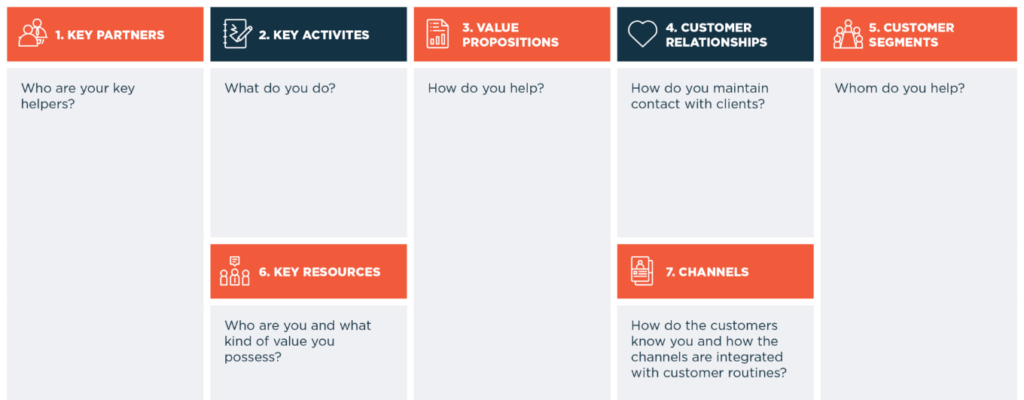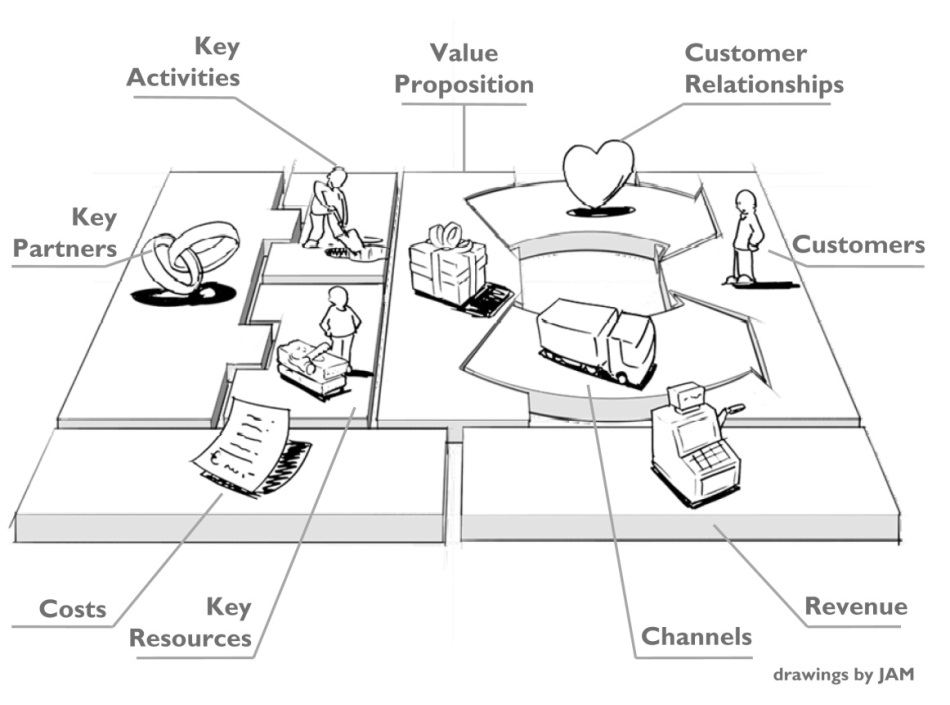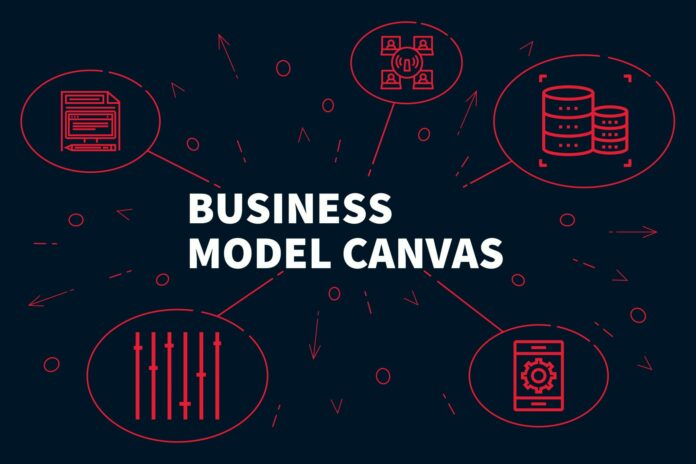The Business Model Canvas is a conceptual and management template for creating new business models or recording current ones. Business Model Canvas is a visual illustration of a company’s or product’s value proposition, infrastructure, clients, and financials. It helps companies balance their operations by highlighting possible trade-offs.
Alexander Osterwalder presented the nine “building blocks” of the business model design template seen in the canvas below, known as the Business Model Canvas, in 2005. Large-scale technological advances offer a plethora of creative possibilities and prospects, but they will wreak havoc on incumbent businesses stuck in obsolete Business Model Canvas.
As it was quickly dubbed, the Business Model Canvas template (BMC) has since attracted a sizable following of devotees. The strategy has been used by companies as large as Microsoft, SAP, General Electric, and startups. Let’s take a look at what the Business Model Canvas is and how a software company can use it to achieve success.
Business Model Canvas Nine Building Blocks
The business model canvas is a single diagram that captures these nine business model building blocks. As the primary focus field, it places the value proposition at the heart of the Business Model Canvas. To the value proposition’s right are customer building blocks (customer groups, networks, and relationships), and to the left are infrastructure building blocks (resources, operations, and partners).
 The finance-based building blocks (revenue and cost structure) can be found on the lower half of the diagram.
The finance-based building blocks (revenue and cost structure) can be found on the lower half of the diagram.
- Customer segments: The community of customers that the company aspires to represent.
- Value proposition: A concise overview of the company’s product and how it helps consumers solve challenges or gain value.
- Channels: The mechanisms by which an organization interacts and provides goods and services to its different consumer segments.
- Consumer relationships: The strategies for maintaining customer segments’ relationships.
- Revenue Streams: The business’s income generation and collection processes.
- Essential resources: The organization’s most critical assets for the other business model elements to operate.
- Key activities: The most critical tasks that an organization must complete for its business model to succeed.
- Strategic alliances: The network of suppliers and collaborators that enable the business model to function.
- Cost structure: The big expenditures that must be paid to maintain the business model afloat.
The Business Models Canvas is a free online tool that allows you to create a business model. The Business Model Canvas template can be printed on a broad surface so that groups of people can begin sketching and debating business model elements together using post-it notes or board markers. It’s a hands-on tool that promotes comprehension, debate, imagination, and study.
You can also use online software, such as Visual Paradigm Online, to help you with the innovation process. You can easily design your Business Model Canvas template with Visual Paradigm’s intuitive Business Model editor. It also includes a large number of professionally crafted models that will help you not only get started quickly but also create a professional and visually pleasing design.
What are the benefits of using Business Model Canvas?
Business Strategy Canvas simplifies the process of researching marketing platforms. Determine the most profitable revenue stream and the most important services and activities.

What is a Business Model Canvas, and how do you make one?
Are you prepared to make a Business Model Canvas? Try Visual Paradigm, a highly rated online diagramming platform that includes all Business Model memos and personalized canvas.
- Make a Business Models Canvas first.
- Making use of the memos in the side palette. Drag them into the drawing canvas.
- Save your completed work to our cloud storage (File > Save as) for future access. You can also share your work with your coworkers by exporting it as an image (JPG, PNG, PDF, SVG, and so on).
Free Online Tool
You can easily design your Business Model Canvas template with Visual Paradigm’s intuitive Business Model editor. It also includes a large number of professionally crafted models that will help you not only get started quickly but also create a professional and visually pleasing design.
Include Text in a rich-formatted Format
Text or memos can be used to fill in the blanks on your canvas. You have a lot of formatting and alignment options to format your text the way you want it.
Sticky Reports and Memos
Using colored memos in your style makes it more interactive. In higher versions, users can also access a wide selection of sticky notes.
Personalization
Create your own canvases to suit your company’s requirements. There are over 1000 icons available for use in decoration.
5 Business Models to Inspire You
A collection of detailed building blocks make up the Business Model. Fill in each box with your ideas and opinions to get a preliminary assessment before you start developing. Understanding how the plan works is one thing; following someone else’s lead is quite another. Here are a few examples to get the wheels going in the right direction if you’re still stuck on what should go on your board.
Vehicle Company as an example of a Business Models Canvas
This example uses the Business Model to illustrate a vehicle company’s business strategies and proposition. A great tool for businesses to analyze and identify future business strategies is the Business Model.
LinkedIn as an example of a Business Model Canvas
For each customer segment, LinkedIn has three revenue sources, as seen in this example:
- A paid account that expands one’s social reach.
- A recruiting solution that assists recruiters in managing work postings.
- Advertisements that enable marketers to target an audience based on their profile data.
Uber as an example of a Business Model Canvas
Uber is a famous example for understanding BMC because it is such a well-known company and a great example of technical progress. Uber, like another shared economy company, Airbnb, has two major customer segments: drivers and passengers. The service appears to hire drivers who work in regions with the highest unemployment rates, so this segmentation is often geo-demographic. Uber is also a fascinating marketing case study because, as a revolutionary service, it receives a lot of free media attention.
Lemonade Stand as an example of a Business Model Canvas
Many people’s first experience with running a business is opening a lemonade stand. It’s also a nice and easy example for a Business Model, which is handy. Partners, vendors, resources, and even consumers may all be family and friends in this world.
In terms of revenue sources, they vary from the software model in that they typically boil down to a fixed price for a drink.
Airbnb as an example of a Business Model Canvas
A hotel alternative provider is depicted in this Business Model illustration. Airbnb focuses on two main user segments: visitors and hosts, which can be further subdivided. The same can be said for value propositions: Although some are drawn to the site because of the low prices and better value than hotels, others are looking for luxurious and exclusive experiences that can be quickly found.
Conclusion
No business strategy ever goes exactly as planned. Staying dynamic and ready to act is the only way to be prepared and competitive in an ever-changing market. Instead of spending months or even years implementing a plan that might or may not come to fruition, you can change your processes on the fly in the current environment and outperform rivals while still rising.
Furthermore, through the power of co-creation, you can remain linked to your team and ensure that everyone involved is on the same page. What are the most beneficial practices for building a business models canvas? Please leave your suggestions in the comments section below.


